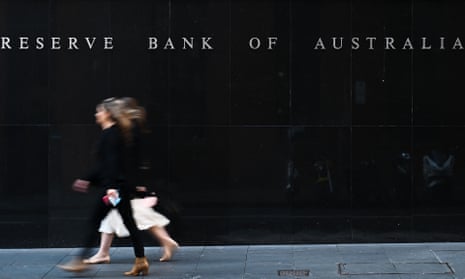With all the forecasting nous reputed to reside inside their HQ in Sydney’s Martin Place, you’d think the Reserve Bank’s intel gatherers should have seen this coming.
It’s been clear for months an inflation data dump would land smack in the middle of an election campaign. Nor could the RBA’s scouts have missed the LED-lit fuel prices and exploding supermarket bills warning that the March CPI would be a big one.
And yet – much like the government’s failure to heed and head off China’s security pact with our erstwhile pals in Solomon Islands – the RBA this week finds itself in a strategic and political bind: lift the cash rate at Tuesday’s monthly board meeting to counter the highest inflation in more than 20 years, or wait until after the election?
Credibility is at stake. Just as Scott Morrison labelled any new Chinese base in Solomon Islands as a “red line” for Australia – dismissed as “ridiculous” in Beijing – the RBA chief, Phil Lowe, has repeatedly stated he wanted to see both inflation trends and an acceleration of the decade-long feeble wage growth before pulling the rate rise trigger.
We don’t get the latter figures until 18 May when the Australian Bureau of Statistics releases the wage price index. But as Saul Eslake, a high-profile independent economist, reckons: “That data may well show that there hasn’t been a significant pick-up in wages growth.”
But the breadth of inflationary pressures now being experienced across the Australian economy “puts the RBA in a position where its credibility would be at serious risk if it doesn’t raise rates [this] week”, Eslake says. “If it doesn’t raise rates, [the RBA] leaves itself wide open to the suggestion that the only reason it hasn’t raised rates is because of the imminence of the federal election.”
John Howard’s bid to win a fourth re-election was famously dented by a rate rise in late 2007. Another mid-campaign rate hike would damage Morrison’s claims – already hurt by the 5.1% CPI number – that the Coalition is a better economic manager than Labor, just 18 days before polls close.
Chatter in Canberra is that RBA boffins are confused about which way to go. Most market economists have predicted a case rate rise this week from a record low 0.1% to 0.25% although the CBA – Australia’s biggest mortgage lender – demurs.
Gareth Aird, CBA’s economics head, says while the inflation spurt might well warrant a rate rise, Lowe has yet to signal a change of policy – as has become the norm for twitchy central bankers.
Instead the RBA had stressed for two years the importance of seeing higher wages. It would be “a blow to their credibility” for the RBA to lift rates before seeing the WPI.
“They would have basically reneged on what they said just two weeks ago [with the release of the April board meeting’s minutes],” Aird says.
Alan Oster, Aird’s counterpart at NAB, takes the opposite view. The RBA has more reputation to shed if it delayed dealing with an inflationary threat that had become increasingly evident at home and abroad, even before Russia’s invasion of Ukraine.
“I think it might actually help their credibility a little bit because, let’s face it, it’s pretty shot as it already is,” Oster says, reeling off a list including last October’s bungled exit of rate-suppression efforts that rattled bond markets.
“Their forecasts for wages, prices, what they would do, what they wouldn’t do – they’re all changed,” he says, with an obvious misfire being the RBA’s view of when rate rises would resume. “Six months ago, they were saying it wasn’t until 2024.”
He says: “They might get a little bit more credit if they actually say, ‘Stuff it, things have changed. We need to move.’”
ASX futures market shows investors predict the RBA's cash rate will be at 2.5% by the end of 2022, whether or not the central bank makes its first move on 3 May. #ausvotes #auspol pic.twitter.com/B2O25E5vm9
— Peter Hannam (@p_hannam) April 29, 2022
Timo Henckel, a senior lecturer at the Australian National University’s research school of economics, says the RBA “boxed themselves into a corner”. Until recently, it had talked up how inflation had been very low and the need to stoke at least moderate inflationary expectations.
Breaking a promise to keep interest rates down for three years to aid the economy through the pandemic two years in hadn’t helped the bank’s standing either.
Henckel, a member of a shadow RBA board that tries to anticipate the bank’s moves, says he remains “50-50” as to whether Lowe will cross his red line and raise rates before receiving the official wages data.
Even so, “I’m just not convinced that the wage number is really going to provide that much additional information,” Henckel says. “What would the wage number have to be for them to decide not to raise it in June?”
Henckel says it’s “a funny view” that a rate rise next week would be a political act given that holding off a month enhances risks that inflation will get out of control and require more drastic rate rises later to rein it in.
“There’s no such thing as neutrality and monetary policy,” he says. “Even if you don’t change interest rates, that’s taking a stand, right?”

Comments (…)
Sign in or create your Guardian account to join the discussion